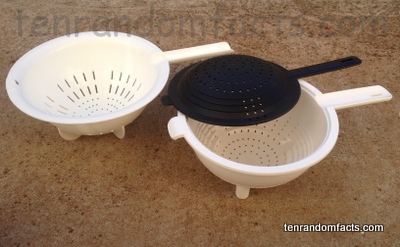The most efficient liquid remover is the colander.
- A colander is a type of sieve, that is an invention used for culinary purposes, to separate liquid from other food.
- ‘Colander’ comes from the word ‘colum’, which means ‘strainer’ or ‘sieve’ in Latin, and they are also known as ‘kitchen sieves’, ‘strainers’ and ‘pasta strainers’.
- Most commonly, colanders are used to strain pasta, and canned items; as well as to rinse or wash vegetables and fruit.
- Common materials used to make colanders include aluminium, ceramic, plastic, silicone and stainless steel.
- Generally, colanders are found in the shape of a bowl, that is often deep, and sometimes they have small legs at the base.
- Colanders feature many holes or slots at the base for liquid to drain, that can range from small to large in size.
- Colanders have been used for thousands of years, and specimens have been found that date back to at least 1300 BC.
- Colanders are typically used over a sink, although a catcher, that is sometimes especially designed and paired with the colander, may be used if liquid flavouring or the like is wanted for other purposes.
- Care should be taken when draining food via a colander, as steam can rise from boiling or hot liquids, and scald.
- Colanders have been used by some religious organisations, notably those that ‘worship’ the Flying Spaghetti Monster from the Pastafarianism organisation, as head coverings.





